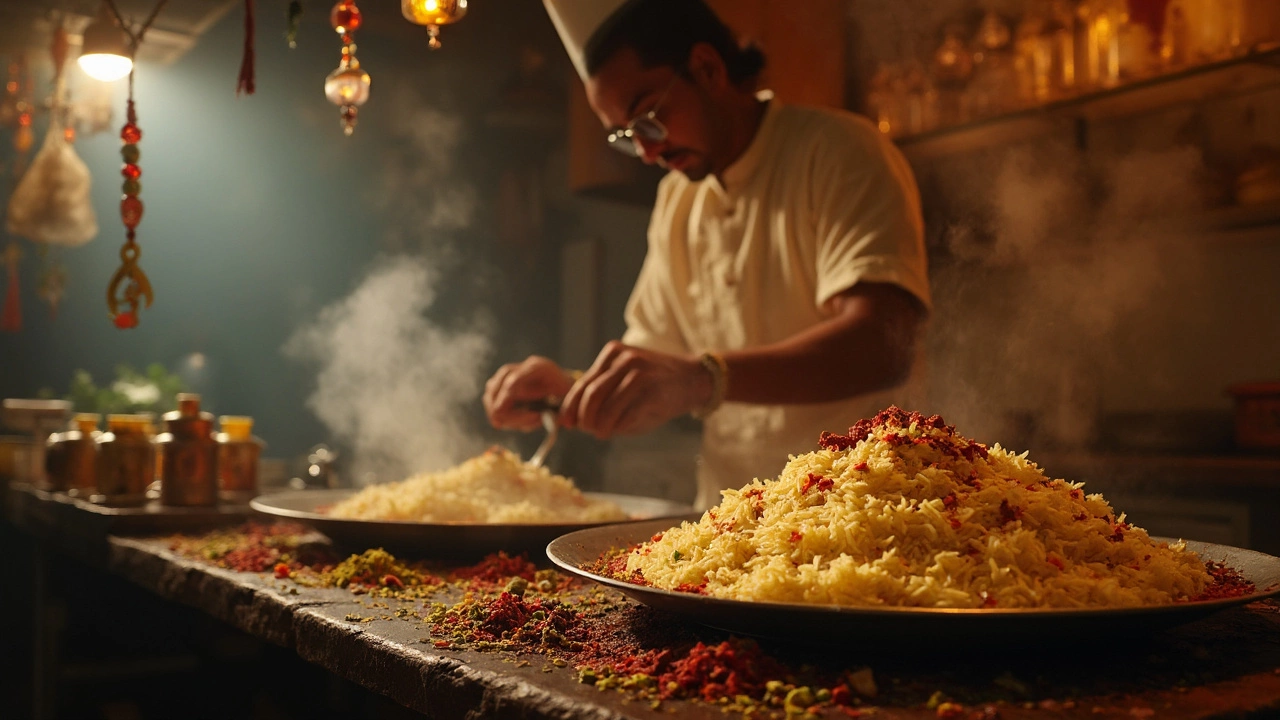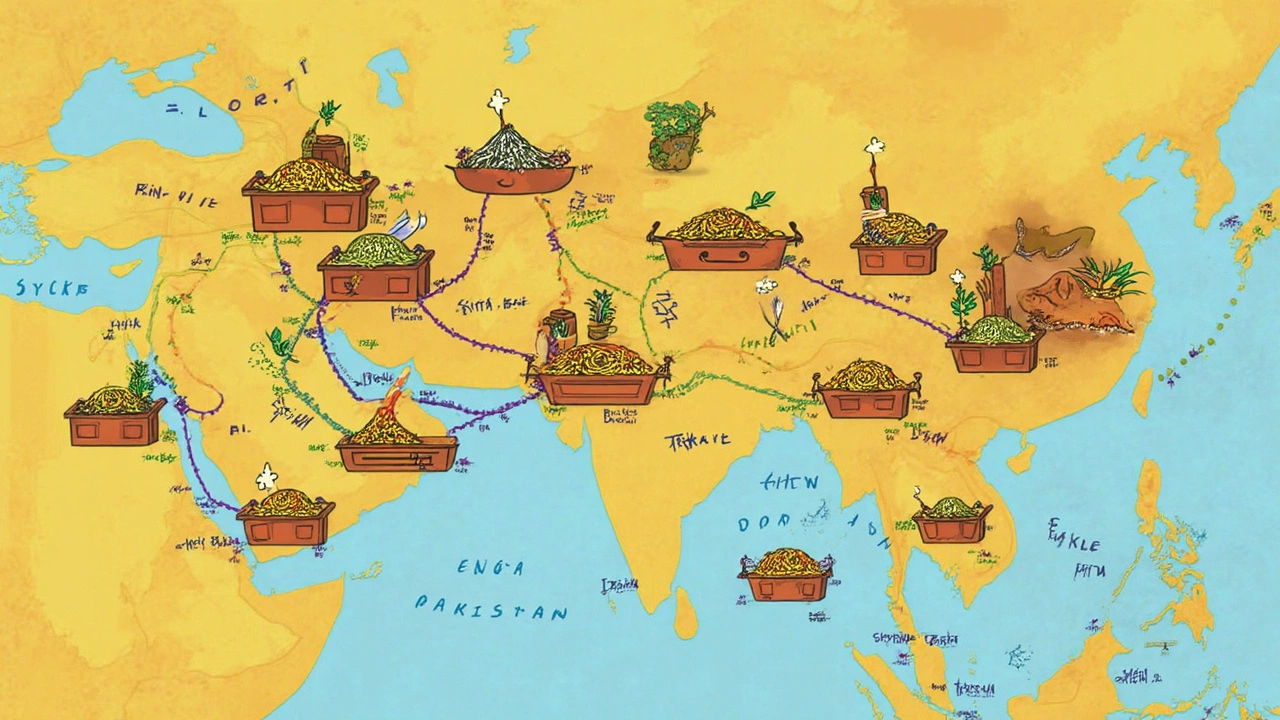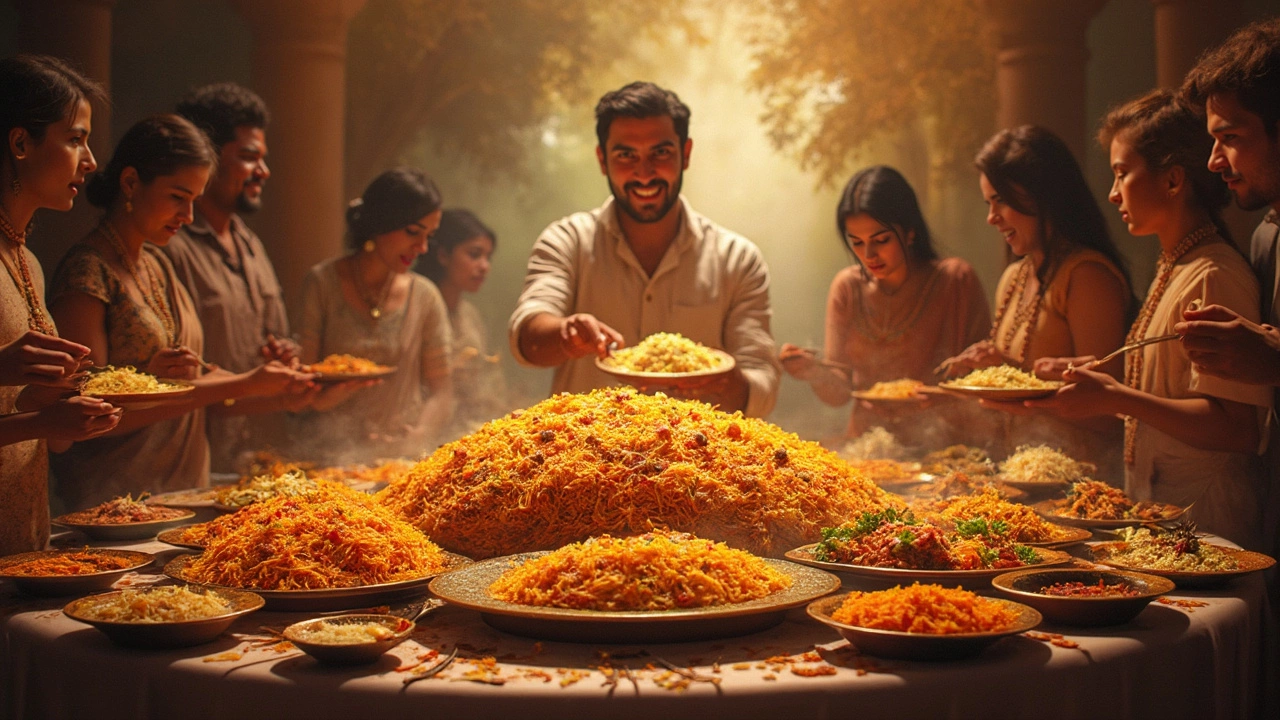4 Mar 2025
- 0 Comments
Biryani is one of those dishes that instantly makes your mouth water. But where does it actually come from? Is it Indian or Pakistani? This delightful debate has been ongoing for years, and while history suggests that biryani has roots in India, Pakistan has undeniably mastered its own unique versions.
What's clear is that both countries offer countless varieties of biryani, each with its own special flair. You've got everything from the hearty Hyderabadi biryani to Pakistan's spicy Karachi biryani, proving the dish is more than just food—it's a rich cultural tapestry.
Now, if you're thinking about trying your hand at making biryani, here's a tip: marinating the meat well can make a huge difference in flavor. And oh, don't forget to soak your rice before cooking; this ensures it gets fluffy and doesn't stick. Curious to know more about perfecting this dish? Let's dig in!
- The History of Biryani
- Indian Biryani Styles
- Pakistani Biryani Varieties
- Common Ingredients in Biryani
- Cooking Tips and Tricks
The History of Biryani
The history of biryani is as spicy and rich as the dish itself. Many believe that it originated from Persia and was brought to the Indian subcontinent by travelers and merchants. However, it really started to gain popularity during the Mughal era, with nobles and royals savoring this flavorful meal.
The word ‘biryani’ actually comes from the Persian word ‘birinj’, meaning rice. The Mughals took this simple rice dish and turned it into a culinary marvel, using it as a way to impress their guests. Imagine huge pots of steaming biryani served at royal banquets, each grain of rice seasoned to perfection. Talk about a royal treat!
Mughal Influence
When the Mughals invaded India, they brought with them not just architecture, but a love for combining rice with meats, spices, and saffron. This was a turning point in Indian cuisine, with various regions adapting the dish to their tastes. This evolution is why we have a myriad of biryani styles today.
Indian vs. Pakistani Biryani
Now, the debate of whether biryani is Indian or Pakistani can get intense. Both nations claim to have the original version, yet both have evolved to make distinct styles. In India, you’ll find variations like Hyderabadi and Lucknowi, while in Pakistan, Karachi and Sindhi biryanis reign supreme.
Interestingly, a food survey in 2022 showed that biryani was the most ordered food item across India and Pakistan. Yep, biryani is that beloved. It's a dish that transcends borders, becoming a symbol of shared heritage rather than division.
Indian Biryani Styles
India offers a plethora of biryani styles, each with its own touch of regional spices and cooking techniques. The country’s diversity is beautifully reflected in these variations, making Indian cuisine all the more exciting and flavorful.
Hyderabadi Biryani
Let's start with Hyderabadi biryani, arguably the most popular. Known for its rich use of saffron and caramelized onions, it's a crowd-pleaser. This biryani typically uses marinated meat layered between fragrant basmati rice. The secret? Cooking in a 'dum' style where the pot is sealed with dough, allowing flavors to mingle perfectly.
Kolkata Biryani
Then we have Kolkata biryani, which has a unique sweetness to it. Brought over by the Nawabs of Awadh, this style often includes boiled eggs and potatoes, making it a comforting treat. It’s less spicy than its counterparts, focusing on aromatic flavors with hints of kewra and rose water.
Lucknowi Biryani
Lucknowi or Awadhi biryani is another celebrated variant. What sets it apart? The technique of par-cooking the meat and rice separately before layering them. Aromatic spices like cinnamon, mace, and star anise infuse the dish, giving it that signature aromatic profile.
Table of Common Ingredients
| Style | Protein | Special Ingredient |
|---|---|---|
| Hyderabadi | Lamb or Chicken | Saffron, Browned Onions |
| Kolkata | Chicken or Mutton | Potatoes, Boiled Eggs |
| Lucknowi | Beef, Mutton, or Chicken | Mace, Star Anise |
While exploring these styles at home, remember that a balanced marinade can make all the difference. Focus on the spices that define each regional style, and don't rush the cooking process. Enjoy the delicious diversity of Indian biryani and let your taste buds explore the myriad of flavors!

Pakistani Biryani Varieties
When it comes to biryani in Pakistan, every corner of the country seems to have its own unique twist. The iconic Karachi biryani, for example, is famous for its bold, spicy flavors that pack a punch. It's the kind of dish that wakes up your senses with each bite. Featuring hefty amounts of green chilies and black pepper, it's not for the faint-hearted.
Then, there's the Lahori biryani, which takes a slightly less fiery approach but is no less flavorful. It often incorporates a mix of whole spices like bay leaves, cardamom, and cloves, offering a fragrant aroma that’s simply irresistible.
The Sindhi Biryani
Sindhi biryani deserves its own spotlight. Known for its aromatic and tangy taste, it's a beloved variety throughout Pakistan. The secret lies in the yogurt and lemon juice marinade that gives the meat its signature tenderness and tinge. Don’t be surprised to find potatoes in there too—it's like a surprise bonus ingredient!
- Key Ingredients: Chicken, basmati rice, yogurt, lemon juice, ginger-garlic paste, tomatoes, potatoes, green chilies.
Data on Biryani Popularity
Here's a fun snippet: A survey conducted in 2023 found that 81% of Pakistanis listed biryani as their “go-to comfort food” during family gatherings.
Each of these Pakistani biryani types has its own loyal fan base, and variations can even change from home to home based on family recipes. Exploring these regional differences is not just a treat for the taste but also an adventure through Pakistani culture itself.
Common Ingredients in Biryani
When it comes to making biryani, the ingredients you use can take your dish from ordinary to downright spectacular. Whether you're crafting an Indian or Pakistani version, there are some staples you'll want to have handy.
Essential Spices
Biryani is known for its aromatic and flavorful spices. Cardamom, cloves, cinnamon, and cumin seeds are some of the stars of the show. These spices give the dish its distinctive smell and robust flavor. Saffron is another key player, offering a unique color and aroma that screams luxury. For a little heat, don't forget red chili powder or green chilies—this is where Pakistani biryani often gets its kick!
Proteins
While chicken biryani might be the go-to, lamb, beef, or even seafood can be used. Marination is crucial in getting that depth of flavor. Yogurt, ginger, and garlic are common in the marinade, and they tenderize the meat, making it melt-in-your-mouth good.
The Rice
Here, basmati rice reigns supreme. Its long grains are perfect for soaking up all those lovely spices. An important step is soaking the rice before cooking. This ensures it cooks evenly and stays fluffy. A little tip: cook the rice with a bit of salt and a dash of oil to keep it from sticking together.
Herbs and Garnishes
Fresh herbs like mint and coriander add a burst of freshness. Fried onions, raisins, and nuts are commonly used as garnishes, adding texture and a hint of sweetness.
| Ingredient | Function |
|---|---|
| Saffron | Color and Aroma |
| Cardamom | Fragrant Spice |
| Fried Onions | Sweetness and Crunch |
In the end, creating the perfect biryani is all about balance. Mix and match these common ingredients to suit your taste, and you're on your way to biryani bliss!

Cooking Tips and Tricks
Crafting a perfect biryani requires some know-how, but these tips and tricks will get you closer to that inviting aroma wafting through your kitchen. Ready to step up your biryani recipe game?
Marinating Perfection
Marinating the meat is essential. Use yogurt and spices like turmeric, cumin, and a splash of lemon juice. Four hours of marinating is ideal, but if you're short on time, even 30 minutes will enhance the flavor surprisingly well. This step is non-negotiable for both Indian and Pakistani varieties.
The Fluffiest Rice
Soak your rice for at least 30 minutes before cooking. It might seem trivial, but this simple step can help you achieve those longer grains typical of a good biryani. Cook the rice until it's 70% done (just the right side of al dente), as it will further steam during the final assembly.
Layering Like a Pro
Biryani is all about layers. Start with a layer of rice, followed by marinated meat, fried onions, and herbs like mint and coriander. Repeat the layers until you end with a rice layer. A pinch of saffron soaked in warm milk drizzled on top adds gorgeous color and flavor.
Spice It Right
Spices can make or break your biryani. Alongside essential biryani spices like cardamom, cloves, and bay leaves, don't forget to add a pinch of nutmeg or mace to give it that unique aroma you find in restaurant-style biryani.
Steam and Rest
Cook on high heat for 5 minutes to get the steam going, then lower the heat and cook for another 20-25 minutes, placing a heavy lid on the pot to ensure no steam escapes. Once done, let the biryani rest for 10 minutes before serving. This gives the flavors time to blend together perfectly.
The Perfect Pair
Biryani is often served with sides like raita or a simple cucumber salad. If you can, try pairing it with a chilled mango lassi for a refreshingly sweet contrast.
